The Role of Primary Health Care Principles in Mental Health Services
VerifiedAdded on 2020/02/24
|10
|2348
|127
Report
AI Summary
This report delves into the application of primary health care (PHC) principles within mental health nursing (MHN). It emphasizes the significant role of MHN in addressing the widespread prevalence of mental disorders and highlights the cost-effectiveness of integrating MHN into PHC. The report outlines key PHC principles such as accessibility, equity, justice, education, technology utilization, community participation, cultural safety, and health promotion, and how these principles are applied in mental health services. It discusses the roles of nurses in advocating for patient rights, providing education, utilizing technology for assessment and communication, fostering community involvement, and creating culturally safe environments. Furthermore, the report details the importance of health promotion and illness prevention through primary, secondary, and tertiary interventions in the context of mental health. The references used support the importance of the topic.
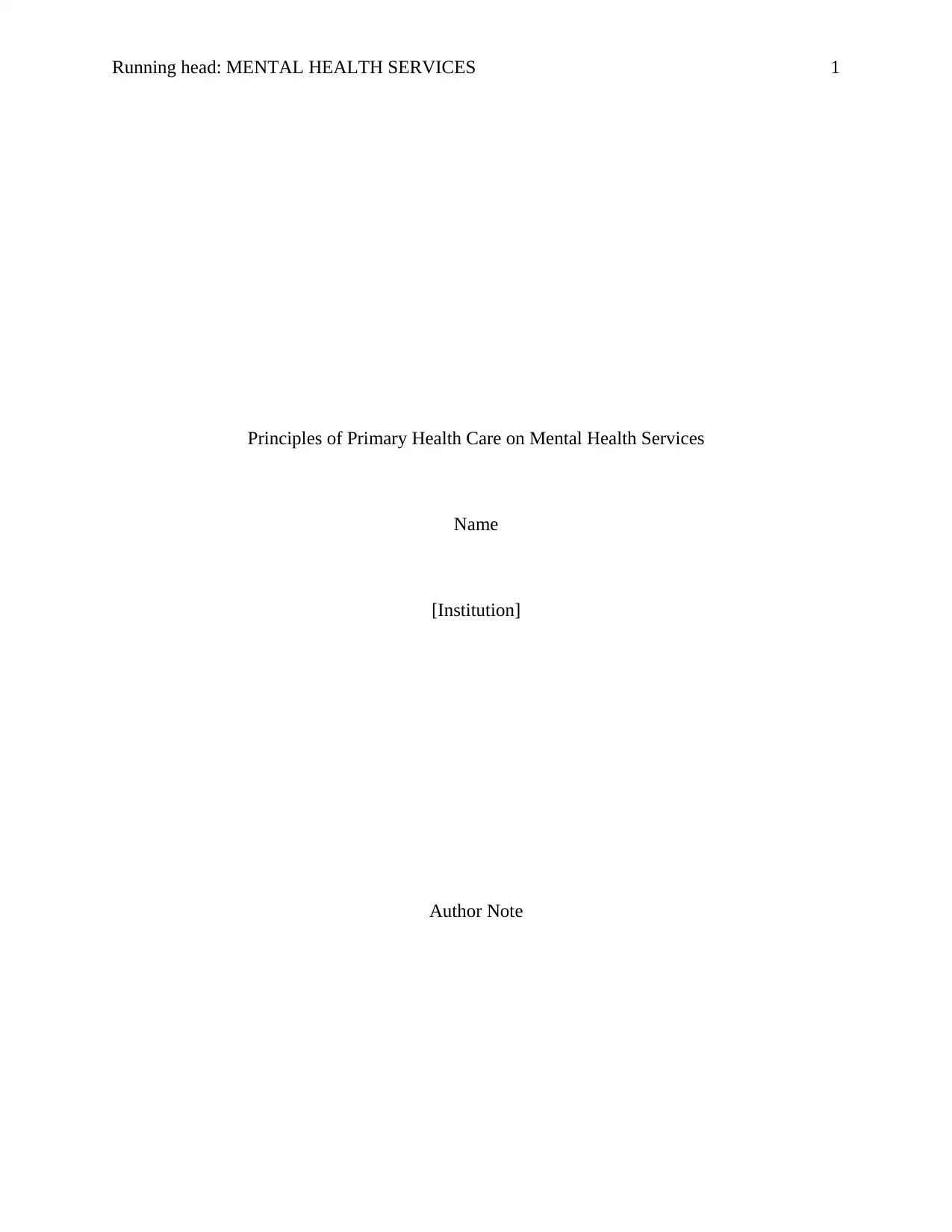
Running head: MENTAL HEALTH SERVICES 1
Principles of Primary Health Care on Mental Health Services
Name
[Institution]
Author Note
Principles of Primary Health Care on Mental Health Services
Name
[Institution]
Author Note
Paraphrase This Document
Need a fresh take? Get an instant paraphrase of this document with our AI Paraphraser
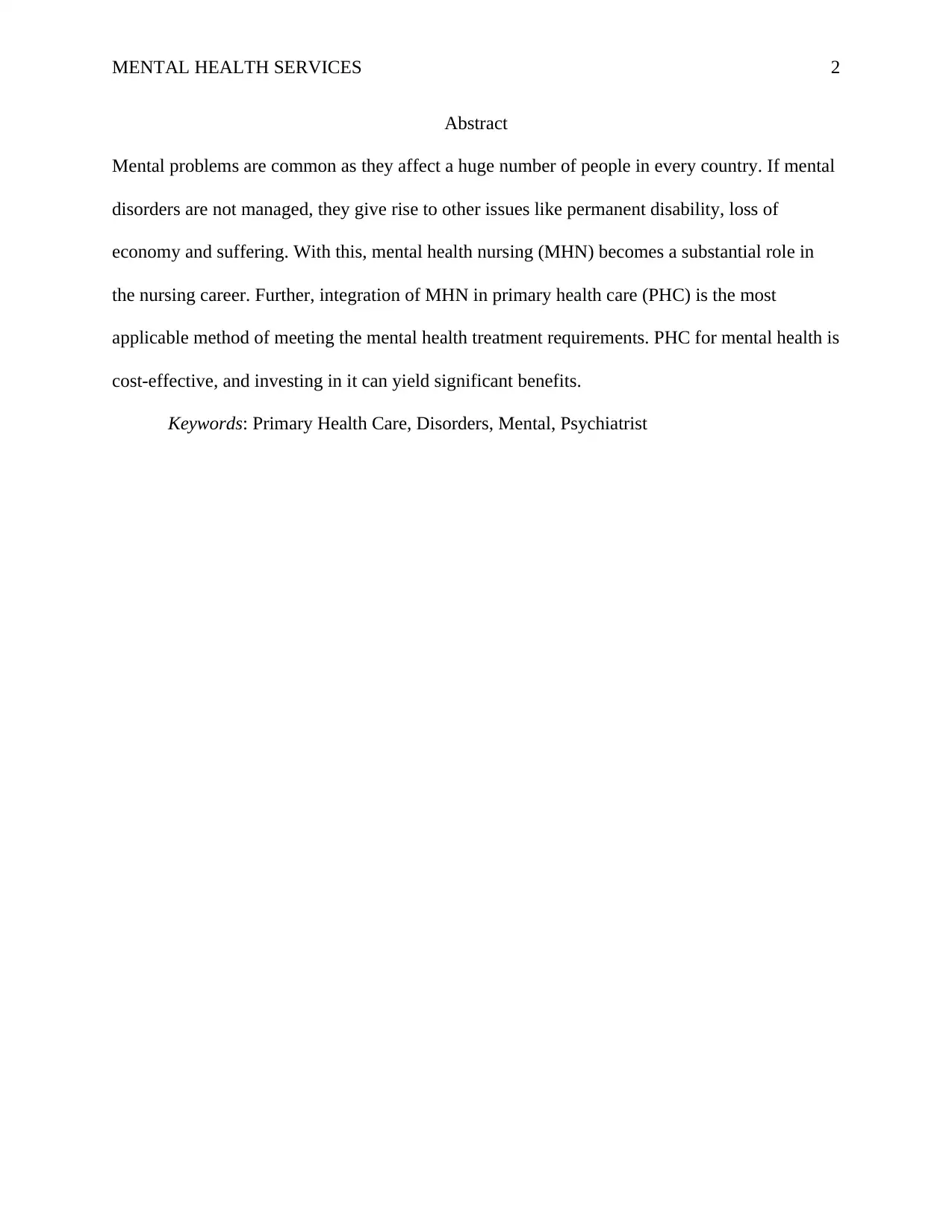
MENTAL HEALTH SERVICES 2
Abstract
Mental problems are common as they affect a huge number of people in every country. If mental
disorders are not managed, they give rise to other issues like permanent disability, loss of
economy and suffering. With this, mental health nursing (MHN) becomes a substantial role in
the nursing career. Further, integration of MHN in primary health care (PHC) is the most
applicable method of meeting the mental health treatment requirements. PHC for mental health is
cost-effective, and investing in it can yield significant benefits.
Keywords: Primary Health Care, Disorders, Mental, Psychiatrist
Abstract
Mental problems are common as they affect a huge number of people in every country. If mental
disorders are not managed, they give rise to other issues like permanent disability, loss of
economy and suffering. With this, mental health nursing (MHN) becomes a substantial role in
the nursing career. Further, integration of MHN in primary health care (PHC) is the most
applicable method of meeting the mental health treatment requirements. PHC for mental health is
cost-effective, and investing in it can yield significant benefits.
Keywords: Primary Health Care, Disorders, Mental, Psychiatrist
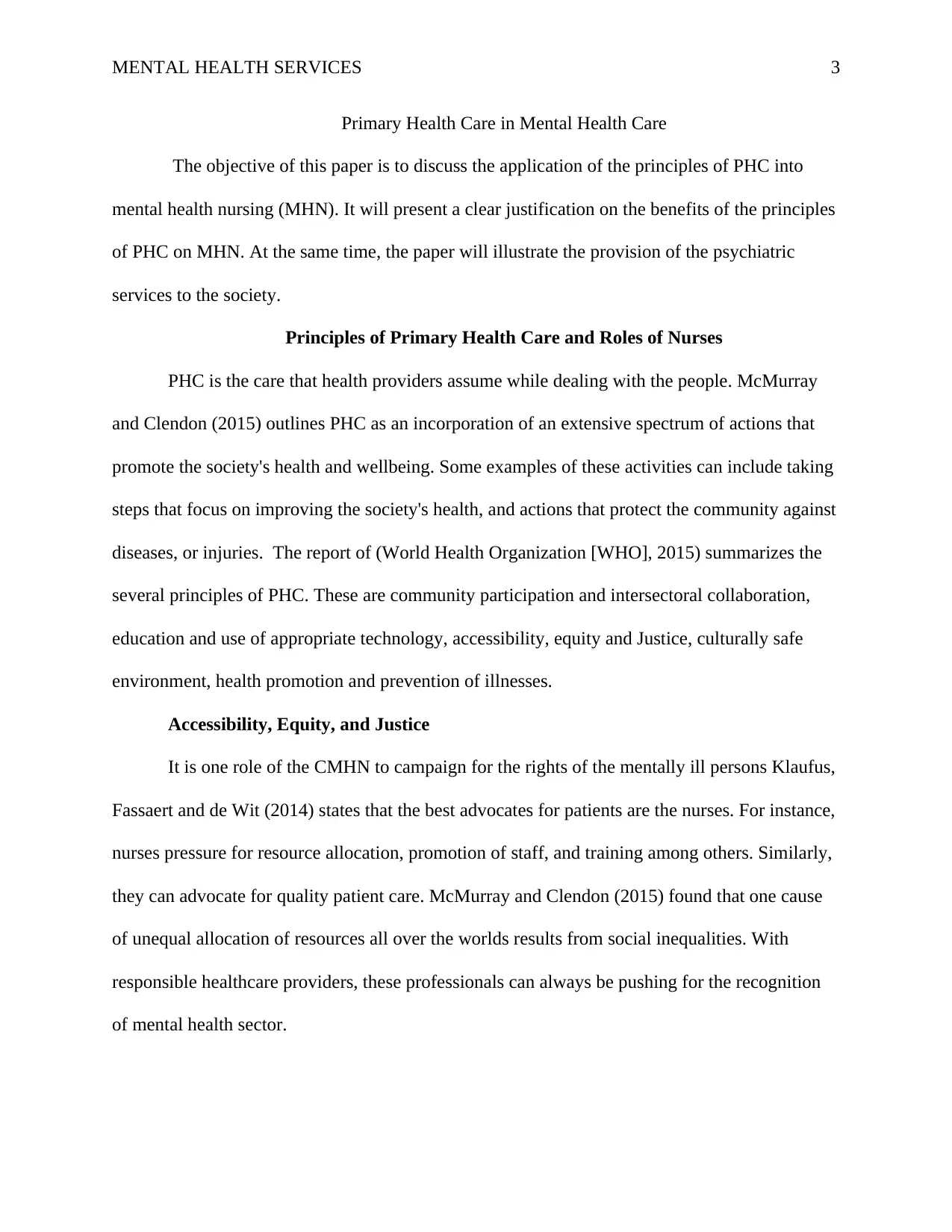
MENTAL HEALTH SERVICES 3
Primary Health Care in Mental Health Care
The objective of this paper is to discuss the application of the principles of PHC into
mental health nursing (MHN). It will present a clear justification on the benefits of the principles
of PHC on MHN. At the same time, the paper will illustrate the provision of the psychiatric
services to the society.
Principles of Primary Health Care and Roles of Nurses
PHC is the care that health providers assume while dealing with the people. McMurray
and Clendon (2015) outlines PHC as an incorporation of an extensive spectrum of actions that
promote the society's health and wellbeing. Some examples of these activities can include taking
steps that focus on improving the society's health, and actions that protect the community against
diseases, or injuries. The report of (World Health Organization [WHO], 2015) summarizes the
several principles of PHC. These are community participation and intersectoral collaboration,
education and use of appropriate technology, accessibility, equity and Justice, culturally safe
environment, health promotion and prevention of illnesses.
Accessibility, Equity, and Justice
It is one role of the CMHN to campaign for the rights of the mentally ill persons Klaufus,
Fassaert and de Wit (2014) states that the best advocates for patients are the nurses. For instance,
nurses pressure for resource allocation, promotion of staff, and training among others. Similarly,
they can advocate for quality patient care. McMurray and Clendon (2015) found that one cause
of unequal allocation of resources all over the worlds results from social inequalities. With
responsible healthcare providers, these professionals can always be pushing for the recognition
of mental health sector.
Primary Health Care in Mental Health Care
The objective of this paper is to discuss the application of the principles of PHC into
mental health nursing (MHN). It will present a clear justification on the benefits of the principles
of PHC on MHN. At the same time, the paper will illustrate the provision of the psychiatric
services to the society.
Principles of Primary Health Care and Roles of Nurses
PHC is the care that health providers assume while dealing with the people. McMurray
and Clendon (2015) outlines PHC as an incorporation of an extensive spectrum of actions that
promote the society's health and wellbeing. Some examples of these activities can include taking
steps that focus on improving the society's health, and actions that protect the community against
diseases, or injuries. The report of (World Health Organization [WHO], 2015) summarizes the
several principles of PHC. These are community participation and intersectoral collaboration,
education and use of appropriate technology, accessibility, equity and Justice, culturally safe
environment, health promotion and prevention of illnesses.
Accessibility, Equity, and Justice
It is one role of the CMHN to campaign for the rights of the mentally ill persons Klaufus,
Fassaert and de Wit (2014) states that the best advocates for patients are the nurses. For instance,
nurses pressure for resource allocation, promotion of staff, and training among others. Similarly,
they can advocate for quality patient care. McMurray and Clendon (2015) found that one cause
of unequal allocation of resources all over the worlds results from social inequalities. With
responsible healthcare providers, these professionals can always be pushing for the recognition
of mental health sector.
⊘ This is a preview!⊘
Do you want full access?
Subscribe today to unlock all pages.

Trusted by 1+ million students worldwide
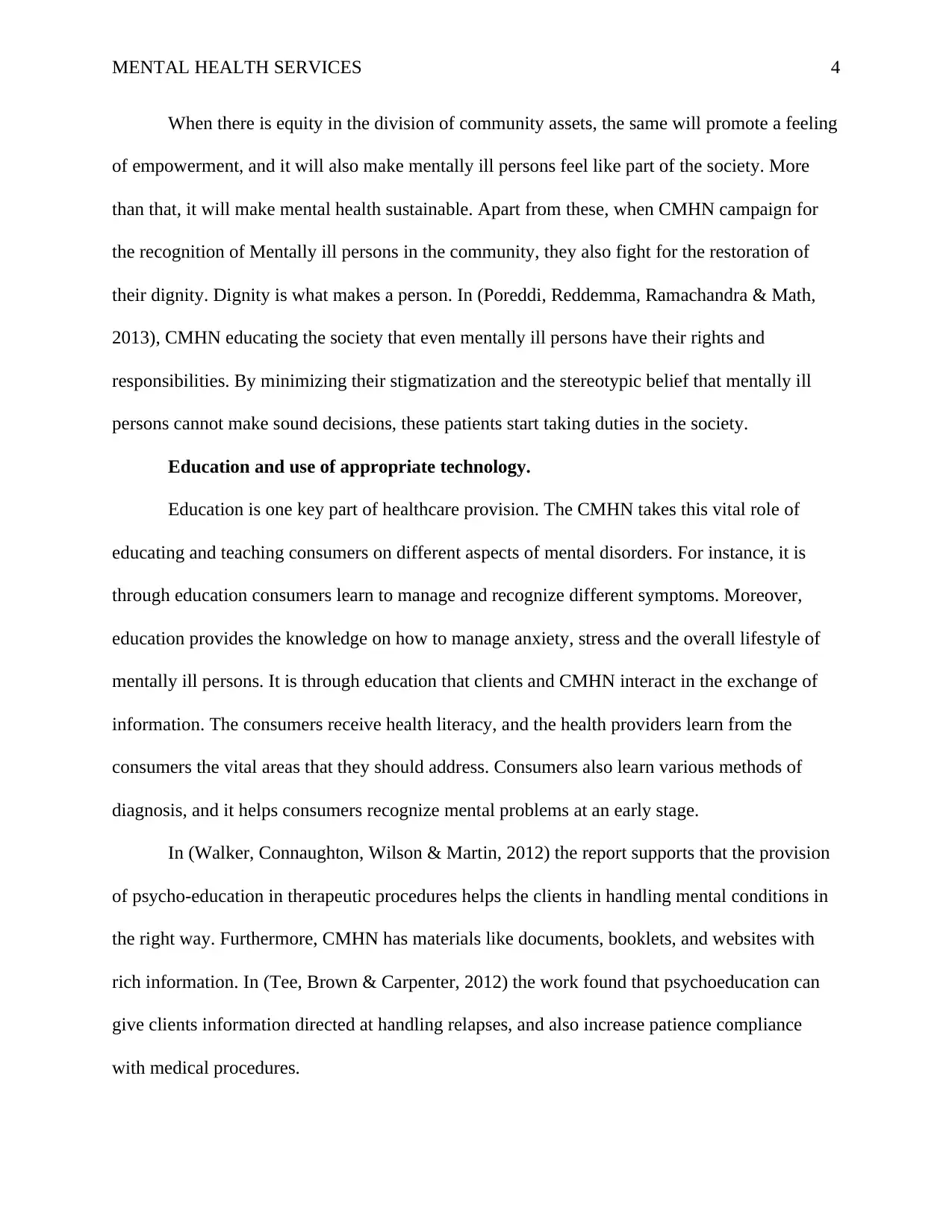
MENTAL HEALTH SERVICES 4
When there is equity in the division of community assets, the same will promote a feeling
of empowerment, and it will also make mentally ill persons feel like part of the society. More
than that, it will make mental health sustainable. Apart from these, when CMHN campaign for
the recognition of Mentally ill persons in the community, they also fight for the restoration of
their dignity. Dignity is what makes a person. In (Poreddi, Reddemma, Ramachandra & Math,
2013), CMHN educating the society that even mentally ill persons have their rights and
responsibilities. By minimizing their stigmatization and the stereotypic belief that mentally ill
persons cannot make sound decisions, these patients start taking duties in the society.
Education and use of appropriate technology.
Education is one key part of healthcare provision. The CMHN takes this vital role of
educating and teaching consumers on different aspects of mental disorders. For instance, it is
through education consumers learn to manage and recognize different symptoms. Moreover,
education provides the knowledge on how to manage anxiety, stress and the overall lifestyle of
mentally ill persons. It is through education that clients and CMHN interact in the exchange of
information. The consumers receive health literacy, and the health providers learn from the
consumers the vital areas that they should address. Consumers also learn various methods of
diagnosis, and it helps consumers recognize mental problems at an early stage.
In (Walker, Connaughton, Wilson & Martin, 2012) the report supports that the provision
of psycho-education in therapeutic procedures helps the clients in handling mental conditions in
the right way. Furthermore, CMHN has materials like documents, booklets, and websites with
rich information. In (Tee, Brown & Carpenter, 2012) the work found that psychoeducation can
give clients information directed at handling relapses, and also increase patience compliance
with medical procedures.
When there is equity in the division of community assets, the same will promote a feeling
of empowerment, and it will also make mentally ill persons feel like part of the society. More
than that, it will make mental health sustainable. Apart from these, when CMHN campaign for
the recognition of Mentally ill persons in the community, they also fight for the restoration of
their dignity. Dignity is what makes a person. In (Poreddi, Reddemma, Ramachandra & Math,
2013), CMHN educating the society that even mentally ill persons have their rights and
responsibilities. By minimizing their stigmatization and the stereotypic belief that mentally ill
persons cannot make sound decisions, these patients start taking duties in the society.
Education and use of appropriate technology.
Education is one key part of healthcare provision. The CMHN takes this vital role of
educating and teaching consumers on different aspects of mental disorders. For instance, it is
through education consumers learn to manage and recognize different symptoms. Moreover,
education provides the knowledge on how to manage anxiety, stress and the overall lifestyle of
mentally ill persons. It is through education that clients and CMHN interact in the exchange of
information. The consumers receive health literacy, and the health providers learn from the
consumers the vital areas that they should address. Consumers also learn various methods of
diagnosis, and it helps consumers recognize mental problems at an early stage.
In (Walker, Connaughton, Wilson & Martin, 2012) the report supports that the provision
of psycho-education in therapeutic procedures helps the clients in handling mental conditions in
the right way. Furthermore, CMHN has materials like documents, booklets, and websites with
rich information. In (Tee, Brown & Carpenter, 2012) the work found that psychoeducation can
give clients information directed at handling relapses, and also increase patience compliance
with medical procedures.
Paraphrase This Document
Need a fresh take? Get an instant paraphrase of this document with our AI Paraphraser
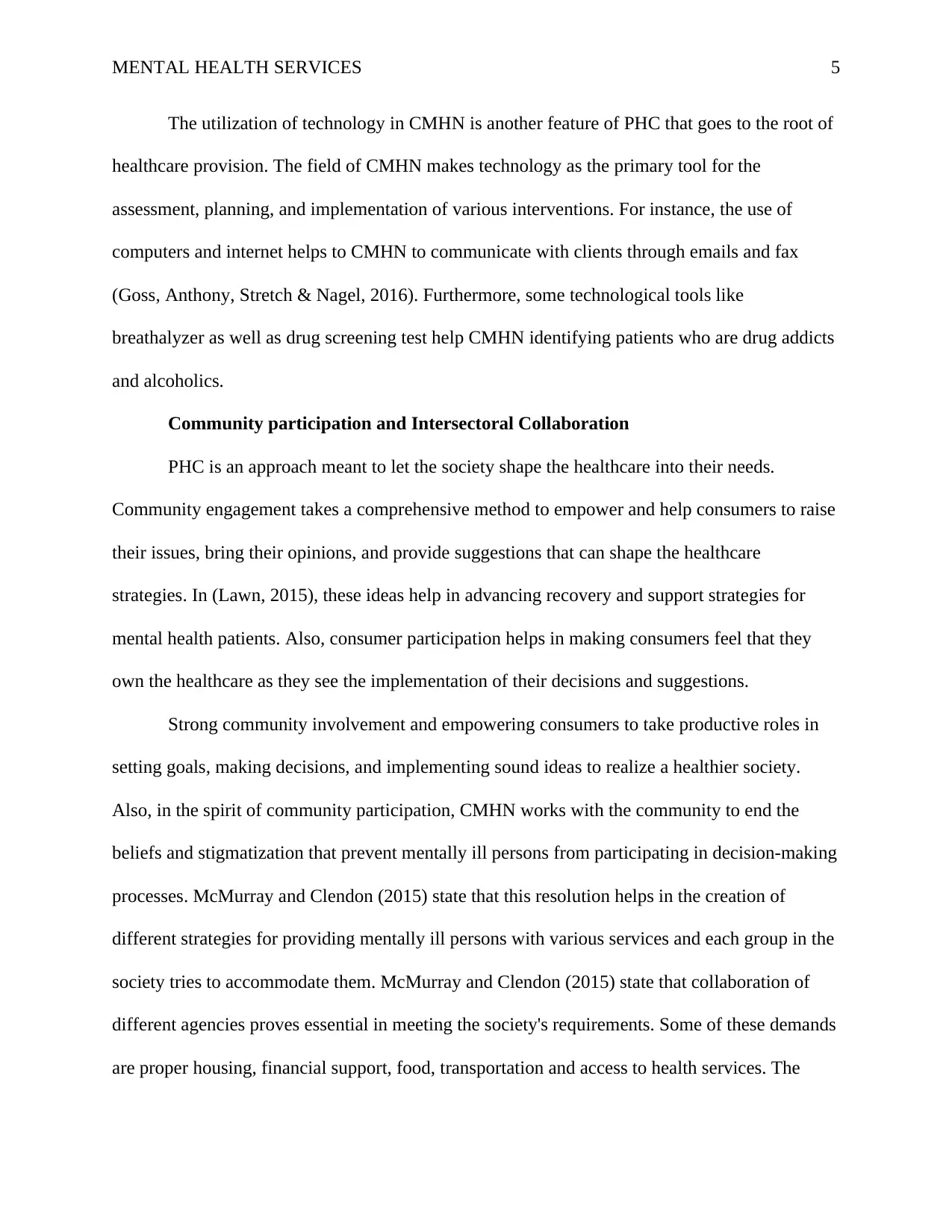
MENTAL HEALTH SERVICES 5
The utilization of technology in CMHN is another feature of PHC that goes to the root of
healthcare provision. The field of CMHN makes technology as the primary tool for the
assessment, planning, and implementation of various interventions. For instance, the use of
computers and internet helps to CMHN to communicate with clients through emails and fax
(Goss, Anthony, Stretch & Nagel, 2016). Furthermore, some technological tools like
breathalyzer as well as drug screening test help CMHN identifying patients who are drug addicts
and alcoholics.
Community participation and Intersectoral Collaboration
PHC is an approach meant to let the society shape the healthcare into their needs.
Community engagement takes a comprehensive method to empower and help consumers to raise
their issues, bring their opinions, and provide suggestions that can shape the healthcare
strategies. In (Lawn, 2015), these ideas help in advancing recovery and support strategies for
mental health patients. Also, consumer participation helps in making consumers feel that they
own the healthcare as they see the implementation of their decisions and suggestions.
Strong community involvement and empowering consumers to take productive roles in
setting goals, making decisions, and implementing sound ideas to realize a healthier society.
Also, in the spirit of community participation, CMHN works with the community to end the
beliefs and stigmatization that prevent mentally ill persons from participating in decision-making
processes. McMurray and Clendon (2015) state that this resolution helps in the creation of
different strategies for providing mentally ill persons with various services and each group in the
society tries to accommodate them. McMurray and Clendon (2015) state that collaboration of
different agencies proves essential in meeting the society's requirements. Some of these demands
are proper housing, financial support, food, transportation and access to health services. The
The utilization of technology in CMHN is another feature of PHC that goes to the root of
healthcare provision. The field of CMHN makes technology as the primary tool for the
assessment, planning, and implementation of various interventions. For instance, the use of
computers and internet helps to CMHN to communicate with clients through emails and fax
(Goss, Anthony, Stretch & Nagel, 2016). Furthermore, some technological tools like
breathalyzer as well as drug screening test help CMHN identifying patients who are drug addicts
and alcoholics.
Community participation and Intersectoral Collaboration
PHC is an approach meant to let the society shape the healthcare into their needs.
Community engagement takes a comprehensive method to empower and help consumers to raise
their issues, bring their opinions, and provide suggestions that can shape the healthcare
strategies. In (Lawn, 2015), these ideas help in advancing recovery and support strategies for
mental health patients. Also, consumer participation helps in making consumers feel that they
own the healthcare as they see the implementation of their decisions and suggestions.
Strong community involvement and empowering consumers to take productive roles in
setting goals, making decisions, and implementing sound ideas to realize a healthier society.
Also, in the spirit of community participation, CMHN works with the community to end the
beliefs and stigmatization that prevent mentally ill persons from participating in decision-making
processes. McMurray and Clendon (2015) state that this resolution helps in the creation of
different strategies for providing mentally ill persons with various services and each group in the
society tries to accommodate them. McMurray and Clendon (2015) state that collaboration of
different agencies proves essential in meeting the society's requirements. Some of these demands
are proper housing, financial support, food, transportation and access to health services. The
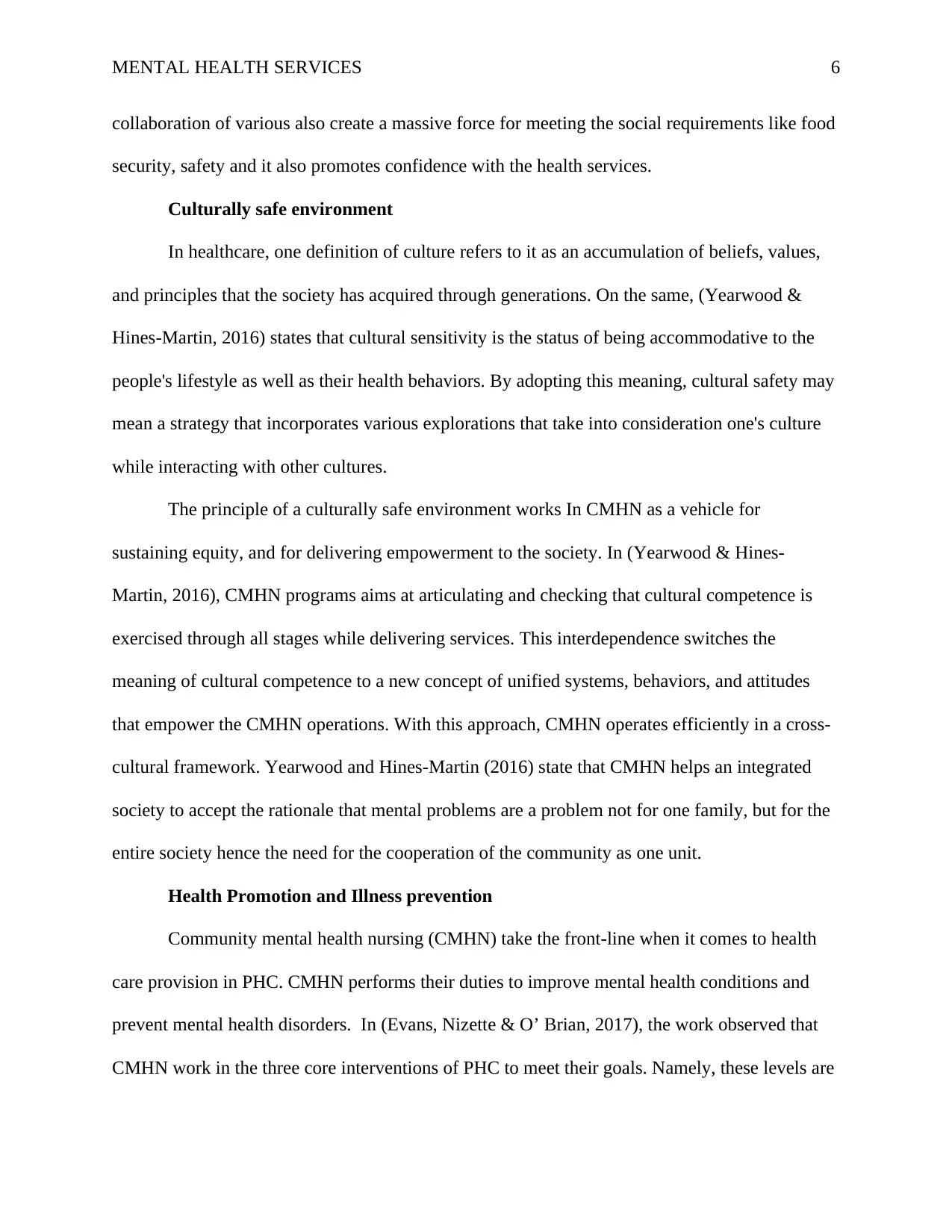
MENTAL HEALTH SERVICES 6
collaboration of various also create a massive force for meeting the social requirements like food
security, safety and it also promotes confidence with the health services.
Culturally safe environment
In healthcare, one definition of culture refers to it as an accumulation of beliefs, values,
and principles that the society has acquired through generations. On the same, (Yearwood &
Hines-Martin, 2016) states that cultural sensitivity is the status of being accommodative to the
people's lifestyle as well as their health behaviors. By adopting this meaning, cultural safety may
mean a strategy that incorporates various explorations that take into consideration one's culture
while interacting with other cultures.
The principle of a culturally safe environment works In CMHN as a vehicle for
sustaining equity, and for delivering empowerment to the society. In (Yearwood & Hines-
Martin, 2016), CMHN programs aims at articulating and checking that cultural competence is
exercised through all stages while delivering services. This interdependence switches the
meaning of cultural competence to a new concept of unified systems, behaviors, and attitudes
that empower the CMHN operations. With this approach, CMHN operates efficiently in a cross-
cultural framework. Yearwood and Hines-Martin (2016) state that CMHN helps an integrated
society to accept the rationale that mental problems are a problem not for one family, but for the
entire society hence the need for the cooperation of the community as one unit.
Health Promotion and Illness prevention
Community mental health nursing (CMHN) take the front-line when it comes to health
care provision in PHC. CMHN performs their duties to improve mental health conditions and
prevent mental health disorders. In (Evans, Nizette & O’ Brian, 2017), the work observed that
CMHN work in the three core interventions of PHC to meet their goals. Namely, these levels are
collaboration of various also create a massive force for meeting the social requirements like food
security, safety and it also promotes confidence with the health services.
Culturally safe environment
In healthcare, one definition of culture refers to it as an accumulation of beliefs, values,
and principles that the society has acquired through generations. On the same, (Yearwood &
Hines-Martin, 2016) states that cultural sensitivity is the status of being accommodative to the
people's lifestyle as well as their health behaviors. By adopting this meaning, cultural safety may
mean a strategy that incorporates various explorations that take into consideration one's culture
while interacting with other cultures.
The principle of a culturally safe environment works In CMHN as a vehicle for
sustaining equity, and for delivering empowerment to the society. In (Yearwood & Hines-
Martin, 2016), CMHN programs aims at articulating and checking that cultural competence is
exercised through all stages while delivering services. This interdependence switches the
meaning of cultural competence to a new concept of unified systems, behaviors, and attitudes
that empower the CMHN operations. With this approach, CMHN operates efficiently in a cross-
cultural framework. Yearwood and Hines-Martin (2016) state that CMHN helps an integrated
society to accept the rationale that mental problems are a problem not for one family, but for the
entire society hence the need for the cooperation of the community as one unit.
Health Promotion and Illness prevention
Community mental health nursing (CMHN) take the front-line when it comes to health
care provision in PHC. CMHN performs their duties to improve mental health conditions and
prevent mental health disorders. In (Evans, Nizette & O’ Brian, 2017), the work observed that
CMHN work in the three core interventions of PHC to meet their goals. Namely, these levels are
⊘ This is a preview!⊘
Do you want full access?
Subscribe today to unlock all pages.

Trusted by 1+ million students worldwide
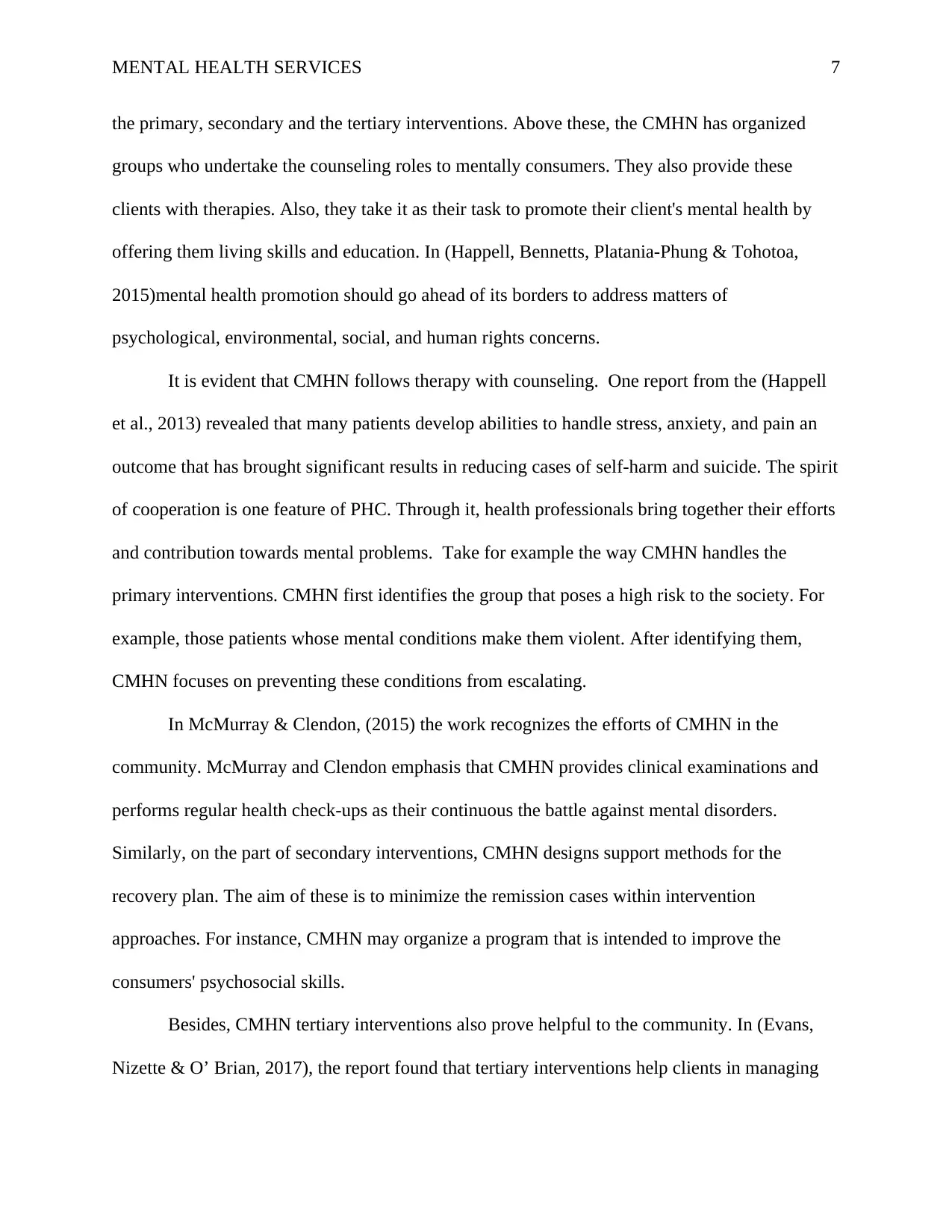
MENTAL HEALTH SERVICES 7
the primary, secondary and the tertiary interventions. Above these, the CMHN has organized
groups who undertake the counseling roles to mentally consumers. They also provide these
clients with therapies. Also, they take it as their task to promote their client's mental health by
offering them living skills and education. In (Happell, Bennetts, Platania-Phung & Tohotoa,
2015)mental health promotion should go ahead of its borders to address matters of
psychological, environmental, social, and human rights concerns.
It is evident that CMHN follows therapy with counseling. One report from the (Happell
et al., 2013) revealed that many patients develop abilities to handle stress, anxiety, and pain an
outcome that has brought significant results in reducing cases of self-harm and suicide. The spirit
of cooperation is one feature of PHC. Through it, health professionals bring together their efforts
and contribution towards mental problems. Take for example the way CMHN handles the
primary interventions. CMHN first identifies the group that poses a high risk to the society. For
example, those patients whose mental conditions make them violent. After identifying them,
CMHN focuses on preventing these conditions from escalating.
In McMurray & Clendon, (2015) the work recognizes the efforts of CMHN in the
community. McMurray and Clendon emphasis that CMHN provides clinical examinations and
performs regular health check-ups as their continuous the battle against mental disorders.
Similarly, on the part of secondary interventions, CMHN designs support methods for the
recovery plan. The aim of these is to minimize the remission cases within intervention
approaches. For instance, CMHN may organize a program that is intended to improve the
consumers' psychosocial skills.
Besides, CMHN tertiary interventions also prove helpful to the community. In (Evans,
Nizette & O’ Brian, 2017), the report found that tertiary interventions help clients in managing
the primary, secondary and the tertiary interventions. Above these, the CMHN has organized
groups who undertake the counseling roles to mentally consumers. They also provide these
clients with therapies. Also, they take it as their task to promote their client's mental health by
offering them living skills and education. In (Happell, Bennetts, Platania-Phung & Tohotoa,
2015)mental health promotion should go ahead of its borders to address matters of
psychological, environmental, social, and human rights concerns.
It is evident that CMHN follows therapy with counseling. One report from the (Happell
et al., 2013) revealed that many patients develop abilities to handle stress, anxiety, and pain an
outcome that has brought significant results in reducing cases of self-harm and suicide. The spirit
of cooperation is one feature of PHC. Through it, health professionals bring together their efforts
and contribution towards mental problems. Take for example the way CMHN handles the
primary interventions. CMHN first identifies the group that poses a high risk to the society. For
example, those patients whose mental conditions make them violent. After identifying them,
CMHN focuses on preventing these conditions from escalating.
In McMurray & Clendon, (2015) the work recognizes the efforts of CMHN in the
community. McMurray and Clendon emphasis that CMHN provides clinical examinations and
performs regular health check-ups as their continuous the battle against mental disorders.
Similarly, on the part of secondary interventions, CMHN designs support methods for the
recovery plan. The aim of these is to minimize the remission cases within intervention
approaches. For instance, CMHN may organize a program that is intended to improve the
consumers' psychosocial skills.
Besides, CMHN tertiary interventions also prove helpful to the community. In (Evans,
Nizette & O’ Brian, 2017), the report found that tertiary interventions help clients in managing
Paraphrase This Document
Need a fresh take? Get an instant paraphrase of this document with our AI Paraphraser
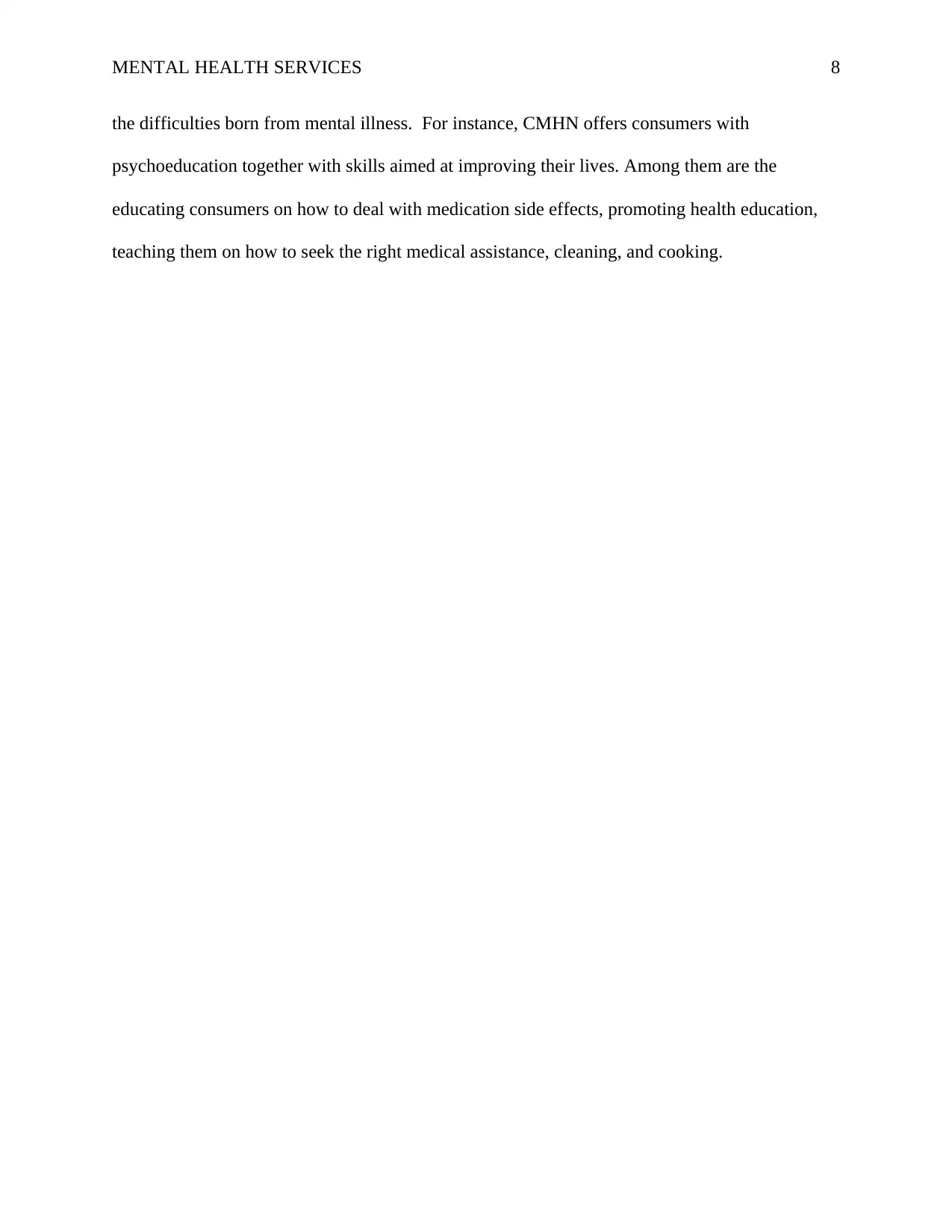
MENTAL HEALTH SERVICES 8
the difficulties born from mental illness. For instance, CMHN offers consumers with
psychoeducation together with skills aimed at improving their lives. Among them are the
educating consumers on how to deal with medication side effects, promoting health education,
teaching them on how to seek the right medical assistance, cleaning, and cooking.
the difficulties born from mental illness. For instance, CMHN offers consumers with
psychoeducation together with skills aimed at improving their lives. Among them are the
educating consumers on how to deal with medication side effects, promoting health education,
teaching them on how to seek the right medical assistance, cleaning, and cooking.
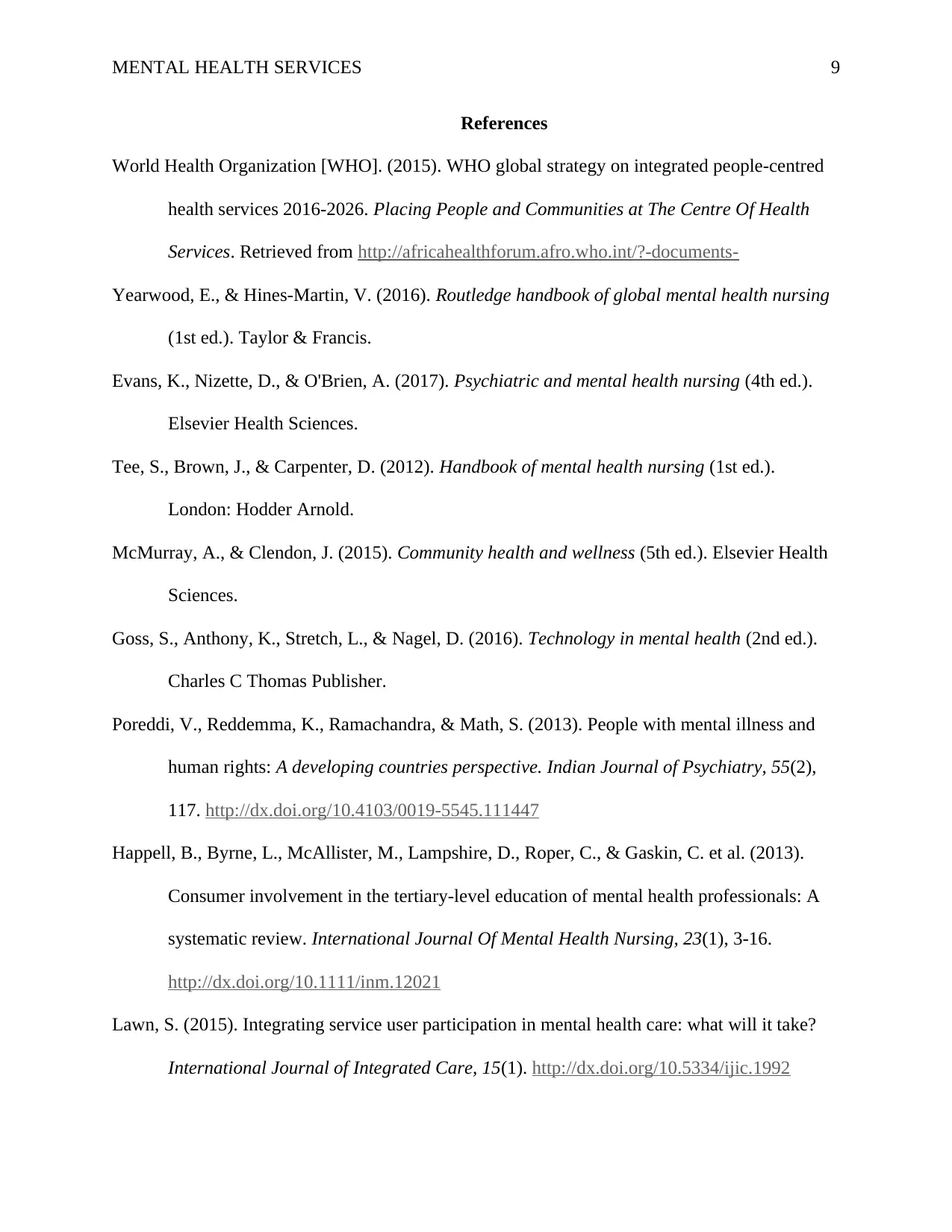
MENTAL HEALTH SERVICES 9
References
World Health Organization [WHO]. (2015). WHO global strategy on integrated people-centred
health services 2016-2026. Placing People and Communities at The Centre Of Health
Services. Retrieved from http://africahealthforum.afro.who.int/?-documents-
Yearwood, E., & Hines-Martin, V. (2016). Routledge handbook of global mental health nursing
(1st ed.). Taylor & Francis.
Evans, K., Nizette, D., & O'Brien, A. (2017). Psychiatric and mental health nursing (4th ed.).
Elsevier Health Sciences.
Tee, S., Brown, J., & Carpenter, D. (2012). Handbook of mental health nursing (1st ed.).
London: Hodder Arnold.
McMurray, A., & Clendon, J. (2015). Community health and wellness (5th ed.). Elsevier Health
Sciences.
Goss, S., Anthony, K., Stretch, L., & Nagel, D. (2016). Technology in mental health (2nd ed.).
Charles C Thomas Publisher.
Poreddi, V., Reddemma, K., Ramachandra, & Math, S. (2013). People with mental illness and
human rights: A developing countries perspective. Indian Journal of Psychiatry, 55(2),
117. http://dx.doi.org/10.4103/0019-5545.111447
Happell, B., Byrne, L., McAllister, M., Lampshire, D., Roper, C., & Gaskin, C. et al. (2013).
Consumer involvement in the tertiary-level education of mental health professionals: A
systematic review. International Journal Of Mental Health Nursing, 23(1), 3-16.
http://dx.doi.org/10.1111/inm.12021
Lawn, S. (2015). Integrating service user participation in mental health care: what will it take?
International Journal of Integrated Care, 15(1). http://dx.doi.org/10.5334/ijic.1992
References
World Health Organization [WHO]. (2015). WHO global strategy on integrated people-centred
health services 2016-2026. Placing People and Communities at The Centre Of Health
Services. Retrieved from http://africahealthforum.afro.who.int/?-documents-
Yearwood, E., & Hines-Martin, V. (2016). Routledge handbook of global mental health nursing
(1st ed.). Taylor & Francis.
Evans, K., Nizette, D., & O'Brien, A. (2017). Psychiatric and mental health nursing (4th ed.).
Elsevier Health Sciences.
Tee, S., Brown, J., & Carpenter, D. (2012). Handbook of mental health nursing (1st ed.).
London: Hodder Arnold.
McMurray, A., & Clendon, J. (2015). Community health and wellness (5th ed.). Elsevier Health
Sciences.
Goss, S., Anthony, K., Stretch, L., & Nagel, D. (2016). Technology in mental health (2nd ed.).
Charles C Thomas Publisher.
Poreddi, V., Reddemma, K., Ramachandra, & Math, S. (2013). People with mental illness and
human rights: A developing countries perspective. Indian Journal of Psychiatry, 55(2),
117. http://dx.doi.org/10.4103/0019-5545.111447
Happell, B., Byrne, L., McAllister, M., Lampshire, D., Roper, C., & Gaskin, C. et al. (2013).
Consumer involvement in the tertiary-level education of mental health professionals: A
systematic review. International Journal Of Mental Health Nursing, 23(1), 3-16.
http://dx.doi.org/10.1111/inm.12021
Lawn, S. (2015). Integrating service user participation in mental health care: what will it take?
International Journal of Integrated Care, 15(1). http://dx.doi.org/10.5334/ijic.1992
⊘ This is a preview!⊘
Do you want full access?
Subscribe today to unlock all pages.

Trusted by 1+ million students worldwide
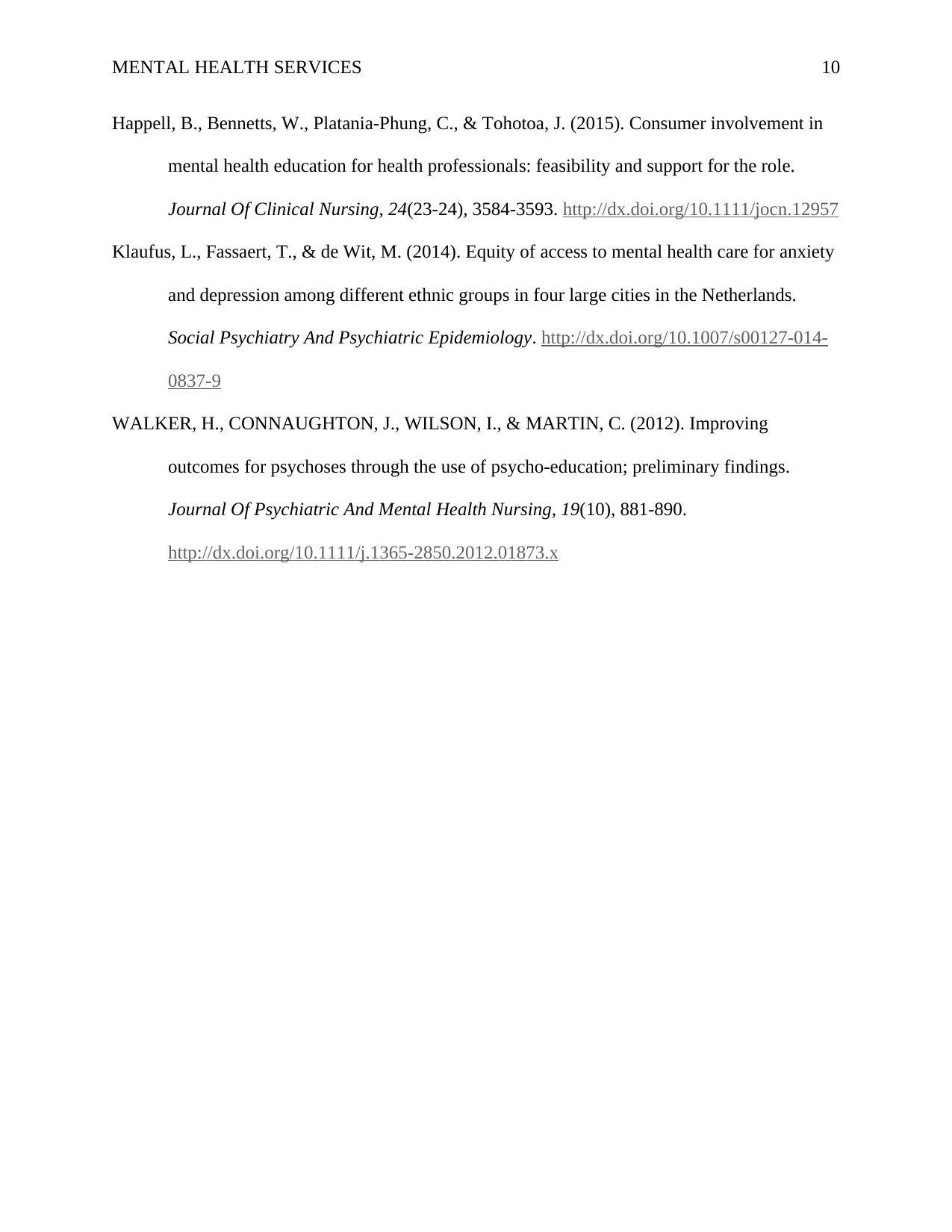
MENTAL HEALTH SERVICES 10
Happell, B., Bennetts, W., Platania-Phung, C., & Tohotoa, J. (2015). Consumer involvement in
mental health education for health professionals: feasibility and support for the role.
Journal Of Clinical Nursing, 24(23-24), 3584-3593. http://dx.doi.org/10.1111/jocn.12957
Klaufus, L., Fassaert, T., & de Wit, M. (2014). Equity of access to mental health care for anxiety
and depression among different ethnic groups in four large cities in the Netherlands.
Social Psychiatry And Psychiatric Epidemiology. http://dx.doi.org/10.1007/s00127-014-
0837-9
WALKER, H., CONNAUGHTON, J., WILSON, I., & MARTIN, C. (2012). Improving
outcomes for psychoses through the use of psycho-education; preliminary findings.
Journal Of Psychiatric And Mental Health Nursing, 19(10), 881-890.
http://dx.doi.org/10.1111/j.1365-2850.2012.01873.x
Happell, B., Bennetts, W., Platania-Phung, C., & Tohotoa, J. (2015). Consumer involvement in
mental health education for health professionals: feasibility and support for the role.
Journal Of Clinical Nursing, 24(23-24), 3584-3593. http://dx.doi.org/10.1111/jocn.12957
Klaufus, L., Fassaert, T., & de Wit, M. (2014). Equity of access to mental health care for anxiety
and depression among different ethnic groups in four large cities in the Netherlands.
Social Psychiatry And Psychiatric Epidemiology. http://dx.doi.org/10.1007/s00127-014-
0837-9
WALKER, H., CONNAUGHTON, J., WILSON, I., & MARTIN, C. (2012). Improving
outcomes for psychoses through the use of psycho-education; preliminary findings.
Journal Of Psychiatric And Mental Health Nursing, 19(10), 881-890.
http://dx.doi.org/10.1111/j.1365-2850.2012.01873.x
1 out of 10
Related Documents
Your All-in-One AI-Powered Toolkit for Academic Success.
+13062052269
info@desklib.com
Available 24*7 on WhatsApp / Email
![[object Object]](/_next/static/media/star-bottom.7253800d.svg)
Unlock your academic potential
Copyright © 2020–2025 A2Z Services. All Rights Reserved. Developed and managed by ZUCOL.





